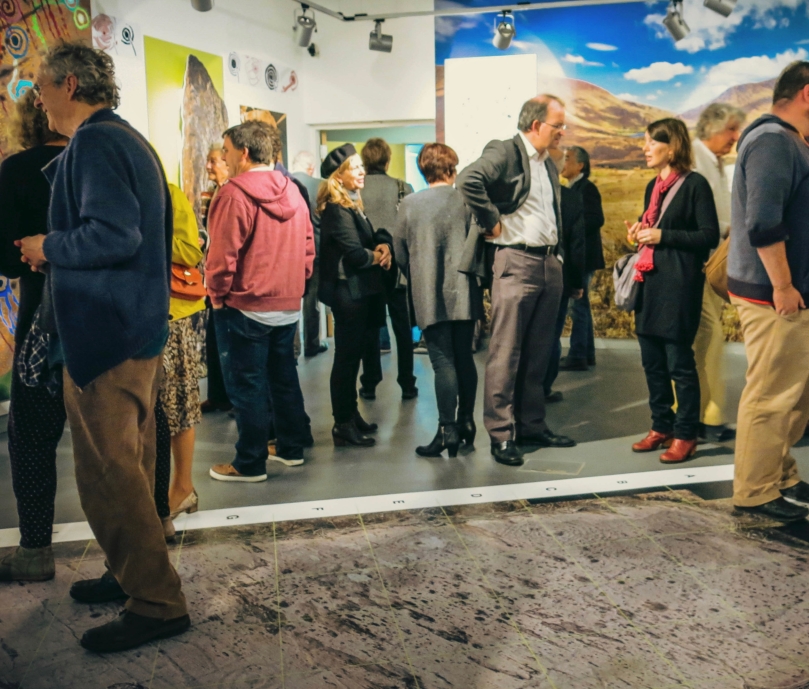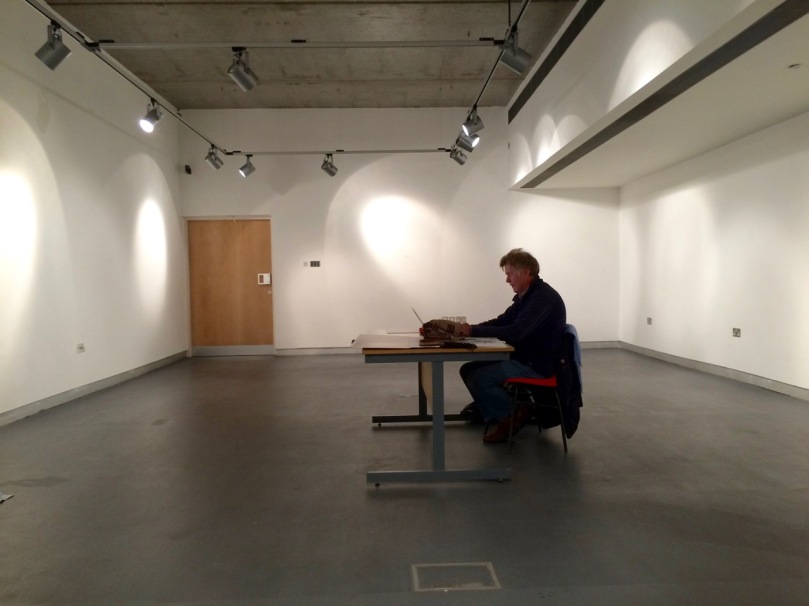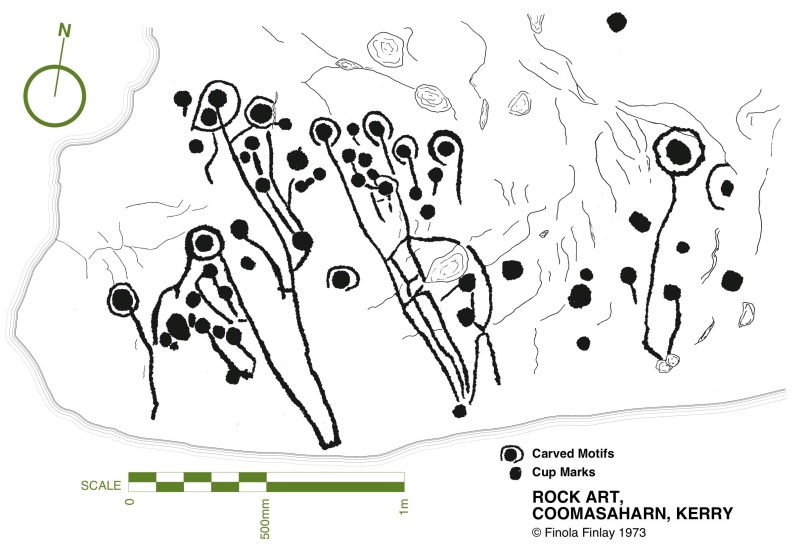A joint post by Finola and Robert
Hallowe’en (All Hallows – Samhain) was the perfect day to launch our Prehistoric Rock Art Exhibition at the Cork Public Museum. As Finola said in her remarks at the opening, it’s a time when the veil between two worlds is at its thinnest: in this case, it’s the veil between an ancient time and the present day. We hope the exhibition emphasises the work of our distant ancestors who have inscribed the landscape and given us the enigma that is Rock Art.
Before the Exhibition – Robert contemplates the blank canvas (top) and installation work in progress (below)
As our regular readers will know, the exhibition has been a very successful collaborative effort: Finola and Robert (providing drawings, explanations and the overall design); Keith Payne, a West Cork painter whose work is inspired by ancient art; Ken Williams, the excellent photographer of megaliths and monuments; the staff of Cork Public Museum, including intern Clare Busher O’Sullivan who came up with the idea and Dan Breen, Assistant Curator and his team, who made sure it all happened.
The Core Team: Clare Busher O’Sullivan, Ken Williams, Keith Payne, Finola Finlay, Robert Harris and Dan Breen
After some intensive days, on site and off, it has all come together and was launched yesterday. It was a grand launch: Firstly, William O’Brien – Professor of Archaeology at UCC – outlined a history of rock art studies and research which started back in the nineteenth century. He mentioned a predecessor in the department – Professor Michael J O’Kelly – who was born exactly 100 years ago and is best known for his excavations and restoration work at Newgrange, the Boyne Valley passage tomb: Finola worked on those excavations and it was Professor O’Kelly who suggested that she should carry out the research on rock art in Cork and Kerry which led to her Master’s thesis on the subject in 1973 – and, 42 years later, to the undertaking of this exhibition.
Professor Michael J O’Kelly (left) was renowned for his work at Newgrange (right)
Next up was Finola, who told us more about her expeditions back in the early 1970s. In those days when the boreens of rural Ireland were mostly populated by donkey carts her own travel was by means of her brother’s Honda 50 motorcycle, and we pictured her loaded down with compass, tapes, chains, chalk and tracing paper – a recording methodology now completely out of favour. But the result was a set of beautiful monochrome illustrations that form the core of the exhibition.
Rock Art: a detail of the picking technique (top left), and Finola’s drawings from 1973
In our modern days non-invasive recording methods have to be used: Ken Williams has developed a very effective method of photography using slave flash units to provide low angle lighting over the carved rocks, which brings the maximum level of detail out of the panels. The exhibition contains many fine examples of Ken’s work in this field.
Ken Williams in action: at the Bohonagh stone circle (left) and in the Derrynablaha townland, Kerry (right)
Finola also talked about Keith Payne’s work. He produces large and visually striking paintings based on particular rock art motifs. Two of these artworks are in the exhibition and will inevitably draw the eye, providing a good and colourful counterpart to Finola’s drawings.
Keith Payne at the hanging (left) and at the launch, in front of the remarkable Derreennaclogh stone (right)
The official launch was in the capable hands of Ann Lynch, now Chief Archaeologist at the Irish National Monuments Office. Ann and Finola were fellow students at UCC. Ann outlined the work of her department in recording Ireland’s monuments – and the difficulties involved in pursuing the preservation and protection of these monuments, including Rock Art – before formally declaring the exhibition open.
Ann Lynch, Chief Archaeologist at the National Monuments Office, declares the Exhibition open
Noteworthy exhibits include one piece of Rock Art – the Bluid Stone from County Cork – which is in the safe keeping of the Museum, and will remain on permanent display after the exhibition closes at the end of February next year. The Museum also houses an example of passage grave art from Cape Clear island (prominent in our own view from Nead an Iolair).
Fine Detail: the Bluid Stone under close inspection
Other exhibits include Ken’s superb photo of the iconic stone at Derrynablaha, Co Kerry, in its panoramic setting of a Neolithic landscape. This occupies the whole of the end wall – and is simply beautiful.
Visitors are surprised to see much of the floorspace taken up with a 70% life-sized image of the stone at Derreennaclogh: some hesitate to walk over it, but the printing is on hard-wearing vinyl, so feel free. The idea is to give you the feel of what it’s like to discover and explore the Rock Art out in the field. We have to mention how impressed we have been with the printing work carried out by Hacketts of Cork in the preparation of the exhibition – in particular, we were fascinated to watch the professionalism of their installation of the large items.
Yes – that floor can be walked on!
The timescale is set admirably by Alex Lee’s ‘Neolithic Settlement’ on the approach to the exhibition room. It’s well worth studying closely all the artefacts set out in this, and imagining what life must have been like for our artist ancestors in Ireland four or five thousand years ago.
Alex Lee at work on the Neolithic Settlement
We were delighted by how many of our friends from West Cork and beyond attended the opening, and gave us positive feedback. If you go during the next four months, please sign the visitors’ book. We are so grateful to our friends Amanda and Peter Clarke for being so supportive throughout – and for taking most of these photographs of the event: very many thanks.
Earnest discussions (left) and one of Ken’s superb photographs (right)
Our own day was rounded off by a visit to the Shandon Dragon festival, which processed through the centre of Cork in the evening – another unmissable event which reminds us of ancient times and long-held beliefs…























Wonderful! What a magnificent event, congratulations!
LikeLiked by 1 person
Congratulations on the launch. Hopefully it will bring Irish rock art to a wider audience. Even if a few of the Park’s visitors pop in and are enthused then it will have been a success.
LikeLike
Thanks so much, Roy.
LikeLike
Many congratulations — wish I were there. But the photographs are magnificent and are a consolation for being far away.
LikeLike
Thanks, Angela. Come on over and get your own private show!
LikeLike
Many congratulations to you both, and to the rest of your team; a fine achievement. I’m looking forward to seeing it soon.
LikeLike
And we’re looking forward to your visit.
LikeLike
What a wonderful exhibition. Well done to you both plus the others involved. I’m impressed how much you guys are packing into life…..you obviously fire each other up to greater things !
LikeLike
I like that, Perran and yes, I think we make a good team!
LikeLike
Finola and Robert: what an extraordinary accomplishment! I know your collaboration was a labour of love and would have consumed many hours of careful attention and decision making. It looks amazing! So sorry not to be able to view it in person.
LikeLike
Thanks so much, Jean – but you will see it all some day. And meanwhile, we will see you at Christmas!
LikeLike
You must both be congratulated on a superb exhibition – the image of Robert lone in the exhibition room with just a table really shows just how much work went into it. It looks absolutely amazing – wonderful to have Finola’s drawings interspersed with Ken’s excellent photos and Keith’s impressive paintings. The text is also clear, interesting and free from ‘speak’! It was a most enjoyable launch and we are delighted to have been part of the process. Time for another field trip I think!
LikeLike
Field trip TBA shortly. Thanks so much for your wonderful comments and for all those photos! They make the post possible.
LikeLike
The ancients would be proud of you all. Congratulations
LikeLiked by 2 people
Thanks, Patti and John! Wish you’d been here – we missed you!
LikeLike
Hearty congratulations Finola and Robert!
LikeLiked by 1 person
Thanks, Helena – wish you could have been here!
LikeLike
I thought of you yesterday and am especially glad to see that a young ‘un was interested! Well done F & R.
LikeLiked by 1 person
Thank you, Shauna! The Young ‘Un is Ken’s son and a veteran of prehistory field trips. It was a lovely day.
LikeLike
I have been thinking about your launch this weekend — thanks for sharing the details and the photos!!
LikeLiked by 1 person
You will see it for yourself next year – the rock art, that is!
LikeLike
Reblogged this on West Cork History.
LikeLiked by 1 person